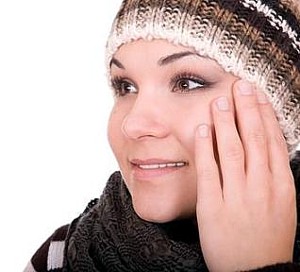Moisturizing Skin Facial For Healing Damage Caused By Harsh Drying Winter Weather
 January 3, 2013
January 3, 2013  Kyriaki (Sandy) Venetis
Kyriaki (Sandy) Venetis  Photo courtesy of skincare-answers.com.
Photo courtesy of skincare-answers.com.
Skin damage is something we all face to some degree as we get older, regardless of skin type, esspecially during the harsh dry winter months.
In more noticeable cases of dry skin, the University of Iowa Hospitals and Clinics call it the “winter itch” and describe the skin’s appear, saying, “The normally fine lines in the skin become more visible, the skin feels rough and appears dull and flaky.”
The university says that dry skin often happens when there isn’t enough water present in the outer layer of the skin, which can happen when the protective oils in the skin are lost because of dry weather, and the water that’s normally present in the skin is allowed to escape.
The university also explains other contributing factors to drying skin are too much soapy water, exposure to harsh chemicals, and the normal aging process that decreases the amount of protective oils in the skin.
Giving advice on the dos and don’ts of taking care of dry skin, the university says, “It’s natural to think that applying water alone to dry skin would help control the problem. However, water alone (especially hot water) can actually worsen the problem of drying skin by removing the normal protective skin oils.
“Hot soapy water depletes the natural skin oils to the greatest degree. Anyone who has tried to wash a skillet covered with bacon grease in cold soapy water knows how effective heat is in softening up oils and fats so they can be washed away. However, [cool] water, followed by the application of oil such as a moisturizer is of the greatest benefit.
“The oil in the moisturizer helps trap and seal water in the stratum corneum (outer layer of the skin) and makes the skin softer, smoother and less likely to become dry, cracked and itchy.”
Giving application advice, the university says that after a shower or bath, “within three minutes of getting out of the water, apply a moisturizer to seal the water in the skin before it can evaporate. Moisturizers should be reapplied liberally during the day and evening when possible.”
For severe irritations, the university adds that any red dermatitis (eczematous) patches should be treated with topical cortisone cream or ointment for a five-to-15 day course. When using both a cortisone product and a moisturizer, always use the cortisone first and the moisturizer second.
The university also cautions to “be careful using any anti-inflammatory and itch-suppressing creams or lotions. Many of these products contain chemicals that can irritate the skin or cause allergic reactions in dry, dermatitic skin.
“A good general rule is if anything that you apply to your skin causes more burning and itching than you started with, you should stop using it until you can talk with your doctor about it. Anti-itch products containing pramoxine (e.g. Prax, Pramosone) or menthol and camphor (e.g. Sama) are generally safe to use. However these products are not treating the cause of skin dryness, they are only temporarily treating the itching that accompanies skin dryness.”
 anti-wrinkle,
anti-wrinkle,  blemishes,
blemishes,  cruelty-free cosmetics,
cruelty-free cosmetics,  facial products,
facial products,  moisturizing,
moisturizing,  vegan products | tagged
vegan products | tagged  natural facial moisturizers,
natural facial moisturizers,  natural/organic moisturizers for dry to normal skin,
natural/organic moisturizers for dry to normal skin,  natural/organic moisturizers for oily and combination skin,
natural/organic moisturizers for oily and combination skin,  natural/organic moisturizers for sensitive skin,
natural/organic moisturizers for sensitive skin,  natural/organic moisturizers with antioxidants,
natural/organic moisturizers with antioxidants,  organic facial moisturizers
organic facial moisturizers 